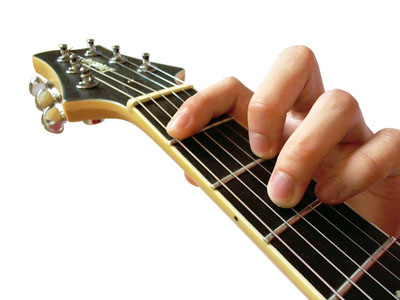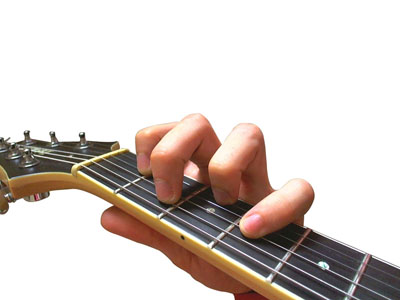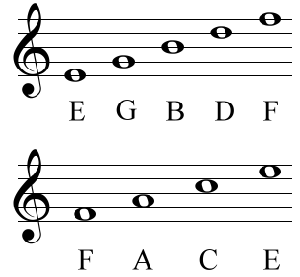Note: You can expand this presentation by clicking on the icon in the bottom right of this video player.
[flv:https://guitartheoryrevolution.info/blog/wp-content/uploads/2011/05/gtrp1.flv 500 388]

Note: You can expand this presentation by clicking on the icon in the bottom right of this video player.
Remember you can zoom in and out on the images in this post by pressing Ctrl + and –
In a previous lesson about chord progressions you may have noticed chords with a 7 behind them V7 or IIm7, examples of which are the G7 and Bm7 chords. These are called 7th chords.
7th chords are chords that consist of 4 notes, starting with a Major or minor triad and playing an extra note on top.
Before I show you how to construct and play these chords let me briefly touch on the naming of intervals and chords. The names 7th and 6th refer to intervals used in these chords. So far in these lessons I’ve avoided using the standard interval names, such as minor 2nd and Perfect 5th because in my opinion they only confuse guitar players who are just starting to learn music theory. The number one priority at this stage is to know how to construct chords and scales and to be able to see them easily on the fretboard.
In future lessons I’ll talk more about standard naming conventions for intervals and then you’ll be able to discuss Augmented 9ths and Perfect 11ths with piano and violin players as much as you want.
Using our method of counting the fret distance from the root note you should easily be able to remember the formulas and apply them to the fretboard using the Five Fret Pattern. Remember the formula for the Major triad is 0 – 4 – 7 and for the minor triad it’s 0 – 3 – 7.
Below you’ll find the name of the chord, the common symbol for it, the formula, an image of all the notes for that chord across the fretboard and an example of of a voicing of that chord. Note that the chord shapes shown are moveable along the fretboard, just play the same shape at different places along the fretboard.
Name: Major 7th
Symbol: M7 of Maj7
Formula: 0 – 4 – 7 – 11
Example: BbMaj7: Bb, A, D, F

Example Voicing: BbMaj7

Name: Dominant 7th
Symbol: 7
Formula: 0 – 4 – 7 – 10
Example: Bb7: Bb, G#, D, F

Example Voicing: Bb7

Name: Major 6th
Symbol: 6
Formula: 0 – 4 – 7 – 9
Example: E6: E, G#, C#, B

Example Voicing: E6

Name: minor 7th
Symbol: m7
Formula: 0 – 3 – 7 – 10
Example: Bbm7: Bb, C#, F, G#

Example Voicing: Bbm7

Name: minor 6th
Symbol: m6
Formula: 0 – 3 – 7 – 9
Example: Bm6: B, D, F#, G#

Example Voicing: Bm6

Learn the formulas for each of these chords and see how many different ways you can play them along the neck, there are quite a few positions for each chord.
One of the challenges for guitar players wanting to learn how to use standard music notation is knowing where on fretboad to play what’s written down on paper. It’s one thing to read music notation and another thing to then play it on the guitar.

This is why tablature is so popular with guitar players, because it shows them exactly where on the fretboard they should play. The downside is that tablature doesn’t convey time, tempo and rythm.
The following diagram is a great tool for bridging the gap between standard music notation and tablature.
Key
As an example lets see where we can play the notes from the above diagram. E, G, B, D, F. Which we can remember with the mnemonic Every Good Boy Deserves Food.
The E is on the bottom line of the musical staff. If you look on the diagram below you can see there are three numbers on the lowest of the five black lines. The numbers are the 12 on the E string, the 7 on the A string and the 2 on the D string.
This means that the E on the musical staff above can be played at the 12th fret of the low E string, the 7th fret of the A string and the 2nd fret of the D string.

These note locations aren’t something you’ll be able to learn overnight. My advice is to concentrate on learning the note locations for the common chords that you play so that you can recognise them when they’re presented to you in standard music notation. For example learn the music notation for these chords.
After that you should start paying attention to the notation of songs that you’re learning to play, not just the tablature. Many song books feature both tablature and standard notation which you can use as a good opportunity to improve your sight reading.
Remember you can zoom in and out on the images in this post by pressing Ctrl + and -. This lesson builds upon Lesson 6: The Five Fret Pattern.

The Five Fret Pattern occurs because of the particular way in which the guitar strings are tuned 5 frets apart. The great thing about this is that it makes the guitar reflect fundamental patterns in western music. This is why I think it’s so important for guitar players to learn music theory for the guitar in a way that is specific to the instrument and not just a rehashing of piano lessons.
If you take any starting note and you keep moving up 5 frets along an imaginary infinitely long guitar string, you will eventually cycle through all the different notes (a real guitar string isn’t long enough but the same thing happens when you move vertically across the strings).

For example, start with the B note on the lowest string, move 5 frets to the right and you’ll find an E (or follow the Five Fret Pattern and move up to the next string). When you move along another 5 frets (or the next string using the Five Fret Pattern) you’ll reach the A note. If you continue following this pattern you’ll encounter all the notes in the following order:
B – E – A – D – G – C – F – A# / Bb – D# / Eb – G# / Ab – C# / Db – F# / Gb and then the pattern starts at the beginning again: B – E – A – D – G – C – F etc. It’s a circular pattern.
To help you remember this pattern more easily you can simplify it to:
B – E – A – D – G – C – F – Bb – Eb – Ab – Db – Gb
Pronounce the first four notes as the word BEAD and remember the next three with the mnemonic Get Carter For me (after the movie Get Carter). Finally repeat the first five note names but as flats Bb – Eb – Ab – Db – Gb.
Now look at the notes on the fretboard again and see how this pattern appears across the strings. Find the B on the lowest string, then the E on the next string, the A etc and remember that this pattern follow the Five Fret Pattern so it shifts over to the right for the two highest strings.
Pick another note on the lowest string, for example the A at the 5th fret. The next notes are D – G – C, then remember to follow the Five Fret Pattern by moving a fret to the right to find F and Bb.
This pattern is another tool to help you learn all of the notes on the guitar fretboard, but it will also help you learn the Circle of 4ths and 5ths, a fundamental tool for understanding music theory. The Circle of 4ths and 5ths will be covered in the next lesson.

Remember you can zoom in and out on the images in this post by pressing Ctrl + and –
I consider the pattern taught in this lesson to be one of the most important things you can learn in order to help your guitar playing. Once you understand this simple pattern your understanding of how the fretboard works will take a giant leap forwards.
One of the things guitar players struggle with when learning music theory is the confusing way in which numbers are used to describe different musical concepts. For example you may have seen how music intervals (the distance between two notes) are described with terms such as Major 2nd or Perfect 5th. As a guitar player it is confusing to relate these terms to the fretboard because they don’t describe the distance in fret numbers, something which you can easily count.
On top of that you might hear people use terms such as whole and half steps or whole and half tones. This is just another needless level of complexity that doesn’t provide any helpful insights. (In case you are wondering half tones and half steps are a distance of one fret and whole tones and whole steps are two frets distance).
In order to make things much easier to learn and help you understand the inner workings of the fretboard we are going to simplify things. By describing music intervals simply by counting the distance in frets between two notes you easily start to notice patterns that will help you learn chords and scales much quickly and you’ll be able to play them all over the neck with ease.
I call the pattern in this lesson the Five Fret Pattern. The pattern is found by placing your finger on any note on the fretboard, in this first example we’ll pick G# on the low E string. This will be our root note or zero point. Since we’re counting a distance we’ll count this as 0 (in the same way that the start of a ruler is 0 cm or inches).

So starting with your finger on the 0 in the white circle, count 5 frets along the string until you reach C#. Now you can also find C# on the 2nd string (the A string) where you see the number 5 in the white circle. The next string up, the number 10 in the white circle is the equivalent of moving 10 frets along the 1st string from the G# on the 1st string. So you can see how all the numbers in this diagram show fret distances from the starting point. Note how the number 24 in the diagram shows a C# but two octaves higher. (You get the next octave up every 12 frets. E.g. 12, 24, 36 etc).
As you can see moving up a string is the same as moving 5 frets along the string. This pattern is easy to remember because its easy to mentally count in groups of 5. The only thing you have to be mindful of is that because of the way the strings are tuned in standard tuning that the pattern on the highest two strings is shifted over towards the bridge by 1 fret.
In the below diagrams you can see what the pattern looks like when you choose your starting point on one of the other strings. Remember that this pattern appears the same way anywhere along the fretboard. All it does is show you relative fret distances.





How knowing the Five Fret Pattern can help you play chords and scales all over the fretboard
Now I’ll show you how this can help your guitar playing. If you know for example that the formula for a Major chord is 0, 4, 7 (0 is the root note plus a note 4 frets along and a note 7 frets along) then you can play Major chords all over the neck by simply placing your fingers on a 0, 4 and 7. (Or equivalents an octave higher. 0+12 = 12, 4+12 = 16 and 7+12 = 19).
Put your finger on a random place on the fretboard and see if you can visualise the Five Fret Pattern with the help of the diagrams. Now see if you can find a 4 and 7 or a 12, 16 and 19 that you can fret at once. Strum these notes and you will have played a Major Chord.
Now see if you can find chords using the Minor Chord formula 0, 3, 7 (Or on higher octaves 0+12 = 12, 3+12 = 15 and 7+12 = 19).
You can also use it to play scales all over the neck. Here is the formula for the Major Scale: 0 – 2 – 4 – 5 – 7 – 9 – 11 – 12. Choose a starting point and count the frets along the string (or on other strings using the diagrams) to find the notes in the scale. 0 is the root note, the next note is 2 frets along, the next one is 4 frets along etc.
Learning this pattern in conjunction with all the names of the notes on the guitar fretboard is one of the best things you can do for your musical education.